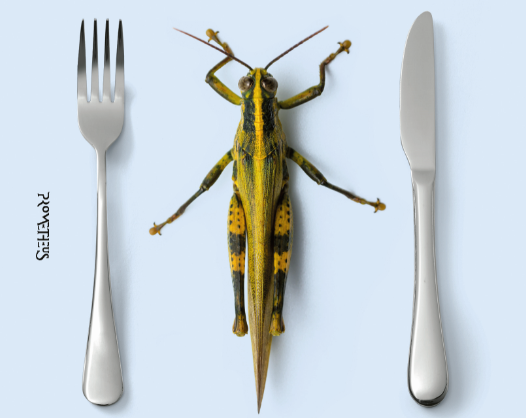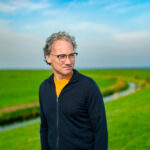Is it going to be possible to feed 10 billion people sustainably in 2050? Wageningen scientists have lined up the options in a readable book for the general public.
We needed a book like this – written for the general public in readable Dutch, thought the initiators, historian Ingrid de Zwarte and governance expert Jeroen Candel. Many of their colleagues proved eager to communicate their ideas for solving the world food problem in 2000 words. The result is a varied array of the latest scientific findings and perspectives on the food system.
‘Everyone in Wageningen is working on the same theme,’ says De Zwarte, ‘but that knowledge is rarely brought together. Let alone in a form that’s accessible to a wider audience.’ ‘Not many of the scientific insights we gain in Wageningen find their way into the public discourse,’ adds Candel. ‘We scientists often don’t invest enough in that, either. Scientists don’t find that dialogue with society easy. This book is meant as a contribution to that.’
The book reads like a sampler of Wageningen know-how. But it is not a corporate product, the compilers emphasize. De Zwarte: ‘It is not a book by WUR for WUR. It is not promotion material, in which particular solutions are put forward. What we want to show is precisely the diversity of ideas. So we leave space for debate, including debate between Wageningen researchers. There are some big established names among the authors, but there are also young researchers and PhD students, who sometimes have a very different take on the issue.’
Politics
10 miljard monden (10 billion mouths) has 41 chapters. Out of that abundance of – sometimes partial – solutions, De Zwarte and Candel have distilled five pathways towards a sustainable food system. Make the system circular, use the potential of nature, keep on pursuing technological innovation, stimulate people to initiate change, and learn from each other at a global level. Each of the insets accompanying this story outlines one such example.
We wanted a book that offers scope for action
The tone of the book is optimistic. And that was a conscious choice, says Candel. ‘We wanted a book that not only describes the scale of the problem, but also offers scope for action.’ And yet the pair are not particularly optimistic about the chances of finding a simple solution to the food supply problem. ‘One of the UN’s Sustainable Development Goals agreed in 2015 was to wipe out hunger in the world by 2030,’ says Candel. ‘But the number of people suffering from undernutrition has only increased since then. It is very urgent, but it seems hard to translate that into political action. I am optimistic about the development of knowledge and the scientific possibilities, but governments and society should take action faster.’ De Zwarte, who does research on hunger and conflict, agrees. ‘In theory we can solve the problem of famine, but in practice all kinds of hindrances, such as war, conflict and the distribution of resources, ensure that there is still hunger in the world. In that sense, I am not optimistic that we can put an end to it with our pathways to a solution. It will take more than that. But hopefully this book can be a starting point for a debate on these issues between scientists, society and politicians.’
1. Make the food system circular
Human livestock feed
Circular agriculture is well represented in 10 miljard monden , which includes a thought-provoking contribution by the philosophers Bernice Bovenkerk, Eva Meijer and Hanneke Nijland. They make a case for a non-anthropocentric perspective on the food system: one in which humans and other animals are equal. The world food problem is as much of a problem for all the animals that we exploit as it is for humans. What gives us the right to eat animals? This line of thought can lead to a vegan form of circular agriculture in which only plant products are consumed. But that’s not the only option. A form of circular agriculture can also be envisaged in which the consumption of animal products is limited. And there’s the rub, admit the philosophers. ‘It is highly questionable whether they (animals, RK) would choose to provide humans with meat, milk or eggs.’ As for being slaughtered, no animal (including humans) would agree to that for fun. Not that it is necessary anymore. Animals can provide cells for producing in vitro meat without having to bite the dust. The authors go furthest at the end of their appeal for equality: in the cycle of eating and being eaten, humans can play their part. Humans as part of the cycle, for instance offering their bodies to wild animals after death. Or, less extreme perhaps, producing in vitro meat from human cells to use in animal feed.
2. Use nature’s potential
Seaweed, the green engine
A lot of potential farmland is still lying fallow. Not on land but at sea. Reinier Nauta (Marine Research), Sander van den Burg (Economic Research) and Adrie van der Werf (Agrosystems Research) explore the potential of seaweed as the crop of the future. The seaweed burger already features on many menus. But there are many more possibilities. In the Netherlands we consume plenty of food additives made out of seaweed, including thickeners such as agar-agar. The authors dream of new products such as wraps and pastas made of seaweed. The advantages of this alternative source of protein are obvious. There is plenty of room at sea and growing it doesn’t require any scarce fresh water. What is more, seaweed captures carbon, nitrogen and phosphate. Does this make seaweed ‘the green engine’ of the future?
Not yet. The technology for seaweed production is still in its infancy, say the authors. The production methods used in Asia are artisanal and labour-intensive. A lot of research needs to go into upscaling. And to farm seaweed on the rough waters of the North Sea would require new production techniques. A lot of research is needed before safe food-grade seaweed can reach our plates.
3. Keep up the technological innovation
Less potato disease
Potato cyst nematodes are one of the three main pests for the potato. Until recently, plant-breeding had made the potato resistant. But the nematodes fought back and now natural selection has led to the emergence of new variants that can infect potatoes. Nematologists Mark Sterken and Hans Helder are playing the genetic detective in an attempt to track down the genes behind this. It is a bit like looking for a needle in a haystack, one gathers from their account of their work. But they report that they are close to finding the needle. Identifying it will make it possible to develop diagnostic tests with which farmers can check their fields for the presence of ‘bad nematodes’. It will also furnish plant-breeders with a more precise focus for the development of resistant potatoes.
4. Stimulate change
A fair price
Cheap goods come at a price. That is certainly true of food, say Willy Baltussen, Geert Woltjer and Katja Longatcheva of Economic Research. The planet pays the price in the end for special offers and two-for-the-price-of-one. A fair price that includes environmental and social costs could be the solution. The researchers describe a way of arriving at that kind of fair price. By working in closed chains (cooperatives), for example, or in open chains with quality labels, or by means of government intervention using subsidies. But none of this is easy. The rather sad conclusion was that it is almost impossible to calculate an objective fair price for food. But you can distribute the costs and benefits of making production more sustainable more fairly among all parties. As long as there is mutual trust and transparency.
5. Learn from each other at the global level
Lighthouse farms
Farms already exist that operate in line with principles of sustainability and circularity — shining examples of what is possible. Professor Rogier Schulte (Farming Systems Ecology) set up a global network of such Lighthouse Farms. The network serves as a kind of ‘global classroom’ for researchers, students and policymakers. The network includes 11 of these beacons of light, among them ERF, the biggest organic farm in the Netherlands, with its 1800 hectares. ERF practises strip cultivation on a large scale, with crops alternating. Schulte and his colleague Annemiek Pas Schrijver do research on Lighthouse Farms around the world. These farms have three things in common: their cultivation system is complex, it requires a lot of collaboration and it requires smart use of technology. Plus they are way ahead of their time.

 Photo: book cover ’10 billion mouths’
Photo: book cover ’10 billion mouths’ 

